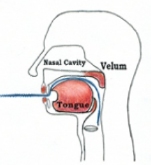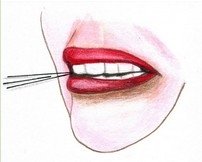Speech Sequence s Sound

Speech sequence s Sound: The speech therapy techniques highlighted on this page are an example of traditional articulation therapy. The techniques can be useful for experienced clinicians.
It is recommended that parents and teachers speak to their local speech therapists or contact professional associations such as ASHA (U.S), SPA (Aus) or RCSLT (UK) for the right information about speech therapy options for your child with speech errors.
Case Example: John is a 5 year old boy with an interdental /s/. That is, his tongue pokes through his teeth to change the /s/ sound to a /th/ sound. This has a very mild impact on his speech but the sound is something that needs to be addressed. You begin speech therapy by explaining to John about the error he is making.
Speech Sequence s Sound: Isolated Sound Level
Clinician: ‘I want you to try this new sound. The sound is /s/. The /s/ is a long stream of air sound and we make the sound by pursing our lips a little and have our tongue near the top of our mouth, but don’t let your tongue poke between your teeth. When your tongue pokes through the /s/ sound becomes the /th/ sound.’
The clinician demonstrates the correct /s/ sound. Demonstrate to the child the correct cue sign at this point and reinforce that the tongue should not poke through the teeth. Practice the new /s/ sound as often as is needed. Once the child is competent at sound level, move onto sound combined with a vowel.
Speech Sequence s Sound: Sound with Vowel
Clinician: ‘I’m happy with your clear and lovely /s/ sound. Let’s try something new. Let’s try the /s/ sound with a vowel. I’ll show you what I mean. s….ooo,’
The clinician demonstrates the /s/ with vowel combination. Note that at this early point that there is a gap between the /s/ and the vowel. This is to protect against the child returning to their ingrained habit of using the /th/ sound. Some possible /s/ vowel combinations are… s…ooo, s…eee, s…ar, s…or, s…ay, s…ir,. Successful sound with vowel is one of the critical points in traditional speech therapy.
John attempts the /s/ and vowel combination. He quickly reverts to his previous use of /th/, so s…ooo becomes th…ooo. The /s/ sound needs to be strengthened. Note, the double sided arrow points both back and forward. In this example, we return to the previous level. John produces /s/ sound in isolation to re-establish the sound. Once the /s/ sound is re-established the clinician tries again with /s/ and vowel.
Once the child is able to produce s…ee, s…oo, s…ar, etc the clinician introduces the concept of the train and carriage as a metaphor of bringing the two sounds together with a visual reinforcement. Attempt s…oo, s..oo, soo, gradually compressing the distance between the consonant and vowel until all cv combos are correct. If the /th/ sound intrudes, return to s…ooo, s…ee to re-establish target sound, as is described in the contingency continuum.
Speech Sequence s Sound: Aspiration Technique
A useful technique to help a child eradicate an intrusive sound error is to use the aspirated /h/ as a carrier phoneme. The /h/ helps ease the distance between the target consonant and the vowel. For instance, with our /th/ for /s/ example, the /th/ continues to intrude so s…ee is intruded upon by s…thee. The /h/ phoneme is technically a consonant but has elements of a voiceless vowel and is perfect for attaching to the …ee vowel to smooth the distance between the /s/ and vowel. So for s…ee we add s…hee.
The /h/ phoneme is very quiet so is not an intrusive sound and blocks the sound error intrusion from attaching to the vowel …ee. The /h/ sound is gradually faded out until the child can confidently produce the target sound and vowel combination without the established sound error intruding.

Click to Download Speech Therapy Sequence for the /s/ Sound
Speech Sequence s Sound: Word Level
At word level you can begin to use the /s/ picture cards. If all the previous stages have been completed successfully then sound at word level will be the next step. While attempting word level speech therapy, if the child returns to /th/ at any point, re-establish the new sound by demonstrating /s/ in isolation or /s/ with vowel.
References
Secord, W. (2007) Eliciting Sounds: Techniques for Clinicians. Delmar ISE
Van Riper, C. & Erickson, R.L. (1996) Speech Correction: An Introduction to Speech Pathology and Audiology. Allyn & Bacon
Williams, A.L. McLeod, S. & McCauley, R.J.(2010) Interventions for Speech Sound Disorders in Children. Paul H. Brookes Publishing Co.
Updated 24/08/2020
